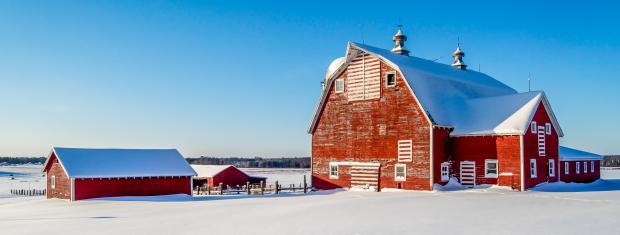
Removing Snow from Farm Outbuildings: 10 Precautions to Consider
When heavy snow meets fierce winds, sometimes even the best-engineered buildings can collapse. Whether you store farming machinery or livestock in your outbuildings, a roof collapse is sure to cause some extensive damage. It’s important to calculate your roof load and obtain adequate insurance for this type of situation.
Understanding Snow Load and Property Damage
Snow load is the downward force on a building’s roof by the weight of accumulated snow and ice. If the snow load exceeds the weight the building was designed to withstand and/or if the building was poorly constructed, the roof or the entire structure can fail.
It doesn’t take a blizzard to wreak havoc on your outbuildings. An imbalance of drifting snow can cause one part of a roof to give, resulting in a domino effect.
Understanding the Weight of Snow
Use this easy formula to calculate the roof load of your structure:
Calculated Roof Loading (lb/ft2) = Depth (ft) x Density (lb/ft2 / ft depth)
The approximate density (lb/ft2 / ft depth) is:
- 5 – 20 for light snow
- 20 – 40 for packed snow
- 40 – 58 for packed snow with ice
- 58 for ice
For example, a roof with 4 feet of light snow has an estimated roof load of 60 pounds per square foot (4 ft depth x 20 lb/ft2 / ft depth density = 80 lb/ft2).
It’s important for you to know the roof weight limits of your barns and outbuildings heading into winter. If necessary, you may consider rebuilding or fortifying them to withstand worst-case scenario snow loads and meet local building standards.
Removing Snow from Outbuildings
Some roof failures can be prevented with cautious snow removal. Consider hiring a professional snow removal contractor to tackle the job. The combination of heights and ice makes this a more dangerous maintenance task.
If you feel confident in working from the height of your outbuilding, we urge you to take the following precautions before getting to work.
10 Snow Removal Precautions
- Always have someone else outside with you in case anything happens to go wrong; never work alone.
- Use a wooden snow roof rake if at all possible. This allows you to stand on the ground in a safe place rather than working from heights. Plastic shovels can also be used.
- Utilize fall protection equipment when yourself or workers are on the roof. Tie yourselves off so that no one falls from the roof.
- If ladders are being used, locate and secure them so they do not slide or collapse while in use, leaving someone stranded on the roof.
- Generally, remove snow from the most heavily loaded areas first.
- Never pile removed snow onto snow-covered roof areas increasing the load in those areas.
- Be mindful of power lines, staying well clear.
- Every last inch of snow doesn’t need to be removed – keep a thin layer of snow on top of the roofs surface to protect it during the snow removal process.
- Do not pick or chip at ice near the roof surface to avoid damaging the roofing material.
- Never use snow blowers to remove snow from a roof, they pose a danger to you and your roof.
The Removal Process
- Using your telescoping snow rake or plastic shovel, start from the outermost edge and work your way into the roof. To avoid an unbalanced snow load, do not remove all of the snow from one side. Instead, remove snow from both sides gradually.
- Try to shave the snow down to 2-3 inches, leaving a thin layer so that the roofing material underneath does not get damaged.
- Remove large icicles carefully if they’re hanging over doorways and walkways.
- Keep gutters and drains clean, free of ice and snow. Make sure downspouts are clear at ground level as well.


